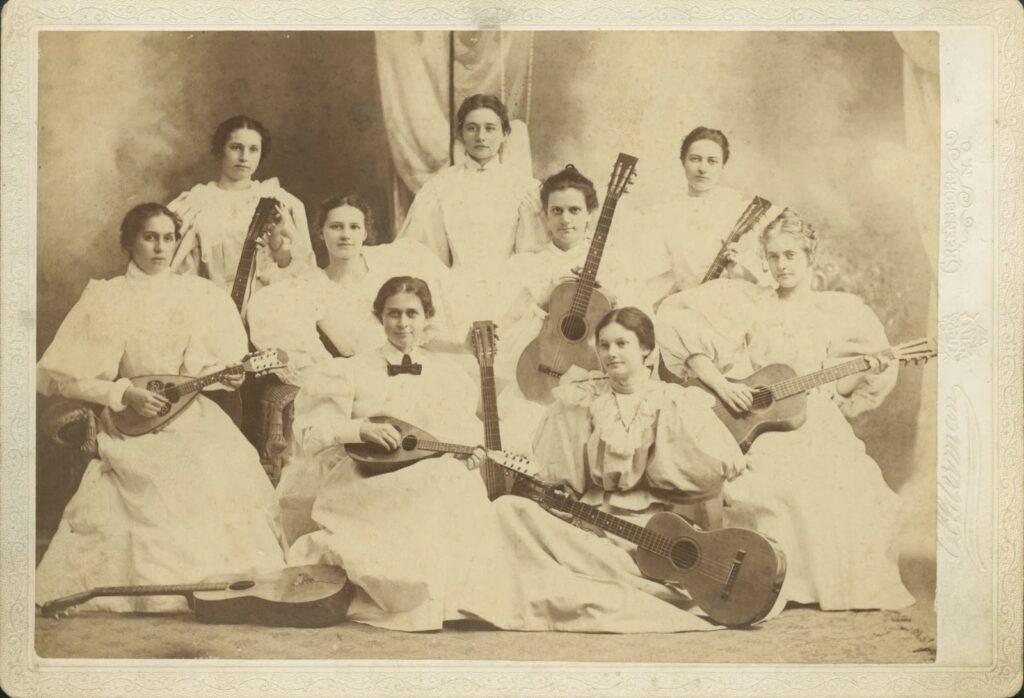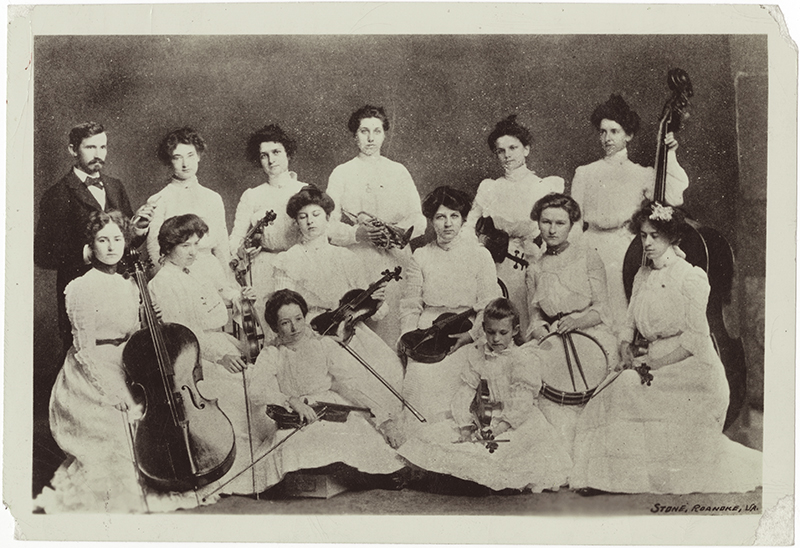
The first students to attend the State Normal and Industrial School in 1892 were greeted by a progressive curriculum, demanding competencies in many disciplines unfamiliar to women of that time. Charles Duncan McIver’s insistence that women educated in a liberal arts curriculum would remedy the state of education in the South acquainted these women with courses in classical languages, history, and literature, in addition to the expected training. With importance on providing education emphasizing a trade or skill set, however, how much support should be devoted to the fine arts? Was there a profit to providing these students with a music education?
Dr. McIver and the Board of Directors believed that at least a modest music education was of use to these future teachers and mothers, creating the Department of Vocal Music. Clarence R. Brown, one of three men in the original teaching faculty, was appointed by McIver, and Lina McDonald was hired as his assistant (McDonald died within a few months after being hired; she was hit by a train walking along west campus). Brown taught music privately in Winston-Salem, and in a letter to McIver, stated that he would not require a high salary, as he could use his trips to the School to recruit Greensboro students for individual instruction. As men faculty earned significantly more than women faculty (the rationale being men carried the financial burden of a family), Brown’s offer was both prudent and convenient. In addition to teaching classes in vocal music, Brown conducted the Glee Club, the first School music ensemble.
In the first annual catalog for the Normal and Industrial School, the Department of Vocal Music advertised itself based on three selling points. First, the department marketed itself by promoting the acquisition of a basic music education as an essential trend for Americans entering the workforce. Furthermore, the departmental mission insinuated that a lack of competency in music is detrimental to religious institutions, as the quality of a service would degrade. Since perpetuating Christian teachings was held as the responsibly of mothers and the female members of a congregation, vocal music instruction was deemed as especially critical for the education of women. Finally, the Music Department boasted itself as a democratic program in stating every student, “regardless of any special talent for music,” should have the opportunity to receive some form of music education. This advocating of music as a universally required skill for women was supported philosophically for all students, but only monetarily for future teachers.
It did not take long for students interested in instrumental performance to petition for instructional support. In 1899, McIver, with agreement from the Board of Directors, hired Charles and Laura Brockmann (brother and sister) to form the Department of Instrumental Music. The Brockmann’s were familiar to the School, having operated the Brockmann School of Music on 410 East Market Street. Also, Brockmann students performed at campus events requiring instrumental music, fulfilling the role of the orchestra. Concentrating on piano and violin performance, the “Infant Orchestra” was introduced the 1900/01 academic year. While popular demand by students for an expansion of this music curriculum undoubtedly stimulated the creation of a new program, there was an additional motive.
Because only classes for vocal music were offered by the School, students interested in instrumental tutelage sought out private instructors. In the Student’s Handbook for 1899-1900, of the ten advertisements featured in the back of the publication, half were offering services towards instrumental music lessons. All studios were near campus, and the prices listed ranged from $2.50-$4.00 per month per student. One instructor offered piano lessons in addition to the cost of board for convenient off-campus housing. Greensboro Female College (now Greensboro College) even paid to promote their voice and piano program in the handbook. Clearly, there was a market for instrumental music instruction, and the State Normal and Industrial School students appeared to be a solid customer-base, willing to pay extra for a more robust music curriculum.
The Department of Vocal Music and the Department of Instrumental Music existed primarily as self-subsidized programs; aside from faculty salary, little money was invested by the state for support. Music was categorized as a special type of class, requiring vocal students to pay an extra $20 in fees and instrumental students an additional $40 (unless they promised to serve as teachers for two years after graduation). Instrumental students brought their own instruments, with the exception of a piano, which under the $40.00 fee, rented the piano for one hour of practice per day. This meant that music students in the 1890s-1910s paid at least 20% more out of pocket to the School compared to other students.
Because music faculty earned income privately from independent students, their salaries were not comparably large. Aside from faculty salary and the purchase of $127.54 in sheet music in 1901, the Departments of Vocal and Instrumental Music were not only financially solvent as independent programs, but potentially profitable for the State Normal and Industrial School. The 1902 Board of Director’s report indicated that the Music Department earned $2,318.17, providing greater income for the campus than the campus farm or the Peabody Fund allotment.
The popularity of the music programs continued to increase. As of 1901, the School began to offer a music concentration within the Normal curriculum. The first Bachelors of Music degree was offered in the 1907/08 school year. Obviously, the special music classes not only were viewed as profitable to students as future educators, but to the institution, as well.
This is part one of a series of posts chronicling the history of music programs at UNCG. Part 2 can be found here.
Article by Stacey Krim

One reply on “Music on Demand, Part 1: Marketing Music Education to the State Normal and Industrial School Curriculum, 1892-1912”
[…] This is part two of a series of posts chronicling the history of music program at UNCG. Part 1 on the funding of the music program can be found here. […]